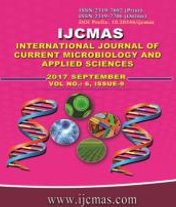


 National Academy of Agricultural Sciences (NAAS)
National Academy of Agricultural Sciences (NAAS)

|
PRINT ISSN : 2319-7692
Online ISSN : 2319-7706 Issues : 12 per year Publisher : Excellent Publishers Email : editorijcmas@gmail.com / submit@ijcmas.com Editor-in-chief: Dr.M.Prakash Index Copernicus ICV 2018: 95.39 NAAS RATING 2020: 5.38 |
The land resources of Chhata tehsil of Mathura district, Uttar Pradesh, India was evaluated for land use planning towards sustainable crop production. The land evaluation is crucial for food security, economic growth and overall development of the nation. Currently, land is being subjected to various kinds of degradations, which calls for its evaluation viz., land capability and land irrigability classification for various land uses. Soils of the study area belong to Inceptisols and Entisols orders. Soils were grouped into 9 soil series, categorized under four land capability classes (II, III, IV and VII) and 8 land capability sub-classes, suitable for crop production as well as silvi-pastoral development. Besides, 4 land irrigability classes and 6 sub-classes were also identified based on the degree of soil limitations for sustained use under irrigation. Socio-economic survey revealed the predominance of rice-wheat cropping system in the area. The results indicated higher average crops yield under large land holding categories among and across the soil series. Amongst all land holdings, highest yield was observed in Garhsauli series for rice, Ladpur series for wheat and sorghum, Simri series for mustard, pearl millet and cotton and Chhata series for sugarcane, respectively. Rice and pearl millet during Kharif season for Garhsauli and Simri series and mustard during rabi season for Simri series are the most suitable land use plans under all land holding categories.
 |
 |
 |
 |
 |